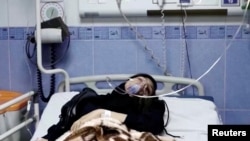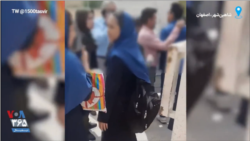Iran has seen renewed poisonings of schoolchildren around the country in the first seven school days of the new Persian year after a holiday hiatus, leaving many Iranians angered but no closer to knowing who is behind the poisonings and why.
In the latest poisonings that have mostly affected Iranian girls' schools, VOA’s Persian service observed credible reports of incidents in 14 cities Tuesday. Those reports, which VOA cannot independently verify because it is barred from reporting in Iran, came from the cities of Amol, Borujerd, Ganaveh, Isfahan, Kamyaran, Karaj, Kermanshah, Mashhad, Oshnavieh, Shahin Shahr, Tabriz, Tehran, Urmia and Zanjan.
Tuesday was the seventh consecutive school day in which poisoning incidents were reported in different regions of Iran.
The Washington-based American Enterprise Institute’s Critical Threats Project team, which has been monitoring reports from Iran of the school poisonings for months, said it recorded one case on April 3, the first school day after educational establishments were closed from March 20 to April 2 for the Persian New Year, or Nowruz, holiday.
AEI said it recorded four more cases on April 4, 10 cases on April 5, 22 cases from April 8 through 10 and seven cases on April 11. Schools were closed on April 6 and 7 for the Thursday-Friday weekend.
No further school poisoning cases were seen in Iran by either VOA Persian or AEI on April 12.
AEI researchers said the April 3 poisoning case was the first they had seen in Iran since March 13, after which they had not observed any cases for a three-week period during which schools were mostly closed for Nowruz.
VOA Persian found that of the cities affected by poisonings Tuesday, Shahin Shahr in the central province of Isfahan was one of the worst hit, with reports of students sickened at 10 girls’ and boys’ schools.
One of those schools appeared to be the Al Yasin girls’ school, seen in a video vetted by VOA Persian and tweeted by the @1500tasvir activist account on Tuesday.
The clip shows a commotion at the school gate as agitated relatives of students kick it open to enable them to leave, after administrators allegedly locked the girls inside.
Iranian Supreme Leader Ali Khamenei has not spoken publicly about the latest school poisonings. His most recent comment came as the last wave of poisonings that began in December reached a peak in early March, when Khamenei’s website quoted him as calling them “a big and unforgivable crime.”
“If anyone is involved in this, the agents and the masterminds must be severely punished,” he said.
Iran’s Interior Ministry announced on March 11 that authorities had “identified, arrested and investigated” more than 100 people in connection with the poisoning incidents. It accused the suspects of having "hostile motives” and trying to “create fear and horror among people and students, shut down schools, and create pessimism toward [Iran’s] Islamic establishment.”
But the Iranian government has not reported any progress in its investigation since then. In an article published Monday, Iranian state news agency ISNA quoted lawmaker Mohammad Hassan Asefari as saying security agencies had not yet been able to uncover the main clues of the poisonings.
Asefari, who is a member of a parliamentary fact-finding committee investigating the causes of the poisonings, also was quoted as saying security agencies should make more efforts to establish the causes of the incidents rather than dismiss them as cases of student mischief.
AEI Iran analyst Kitaneh Fitzpatrick discussed her team’s research into the poisonings in a Tuesday interview for this week’s VOA’s Flashpoint Iran podcast.
The following transcript of her interview has been edited for brevity and clarity.
VOA: How do the latest poisonings compare with those that we saw before the Persian new year?
Kitaneh Fitzpatrick, American Enterprise Institute: The reported poisoning symptoms have remained consistent with what we saw in that earlier period in March. There are scattered reports of children saying that there was an attack or some type of chemical smell within the facility. The students reportedly said the school administrators would not let them leave and closed the doors. They said they were not allowed to talk to their parents, and the administrators did not call the emergency facilities. These reports of an anomalous response from the authorities are consistent with what we saw last month.
VOA: How do you assess the responses of the students, their families and the authorities to what is going on?
Fitzpatrick: Of course, parents remain extremely concerned. There have been a few protests in different areas where these poisonings are occurring due to the regime's response or lack of response.
Regime officials’ messaging has been conflicting at times. There have been some arguments circulating online from regime officials saying that the poisonings are psychosomatic. However, they do acknowledge that poisonings are ongoing and they still have not done enough to protect the students from these ongoing attacks.
VOA: How can we explain the anomalous behavior of Iranian authorities?
Fitzpatrick: I think their behavior is extremely anomalous and inconsistent with the severity of what we perceive to be going on. The regime appears to be tolerating this campaign against Iranian schoolchildren, either because authorities are incapable of preventing these attacks or are unwilling to mobilize the resources they have to prevent them.
VOA: Why has public outrage at the poisonings not manifested itself on the streets of Iran with the same intensity as the nationwide protests of late last year?
Fitzpatrick: I think the outrage that we are seeing from Iranians on the ground is consistent with the outrage at the death of Mahsa Amini. It is outrage at another example of the regime's inability to protect the most vulnerable segments of its population: young children and young adults.
We might be seeing a less intense protest activity because Iranians are tired. They have been protesting for months at great expense to their safety. There is a risk of death, imprisonment and torture [by the authorities]. Also, there is the [weak] economic situation that is ongoing.
That is not to say that there is no possibility of mass protests reigniting. Those anti-regime sentiments are still there and exacerbated by the poisonings. It is just because the duration of this protest movement is so long that it is difficult to sustain that type of momentum.











